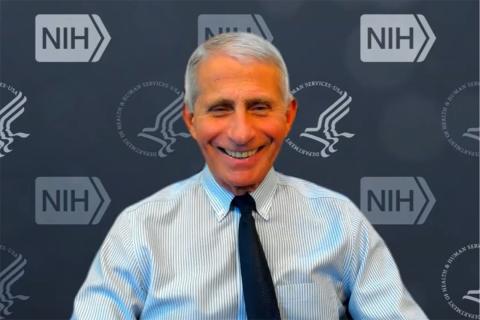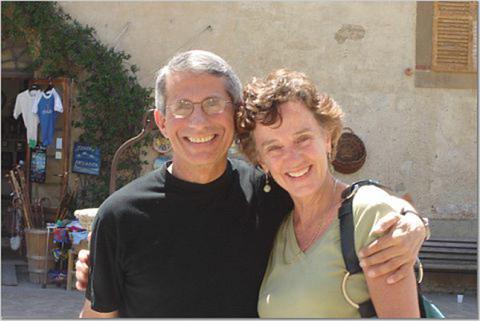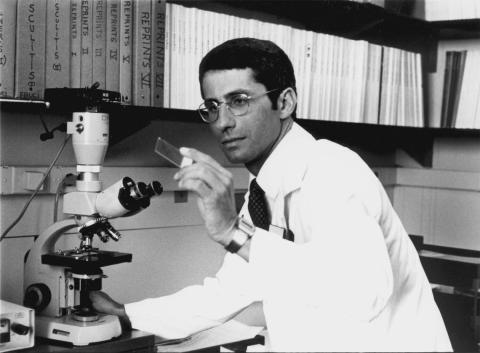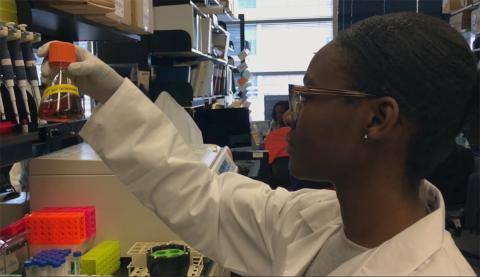‘The Bell-Shaped Curve of Life’
Fauci Discusses Covid Control, Recovery

It was almost inevitable. Despite being vaccinated, double-boosted and cautious, NIAID director Dr. Anthony Fauci got infected with SARS-CoV-2, the virus he has incessantly battled with science, guidance and counsel for the last 30 months.
“The thing that is so perplexing is the extraordinary degree of tenacity of the virus,” said Fauci, who had a lingering, intermittent cough during a June 27 virtual interview.
“We are now in our third year of [the Covid-19 pandemic], of one variant following another variant following another variant. But even with vaccinations, which have been extraordinarily lifesaving, we do not get very good protection against infection. Thank goodness, the vaccines protect against severe disease, which is obviously the most important thing.”
His own bout with Covid-19 in June initially was mild but took an unexpected turn. “I rebounded,” said Fauci, who thought he was out of the woods after a round of the antiviral Paxlovid followed by three consecutive days of testing negative. But the next day, he tested positive again and symptoms soon appeared with a vengeance.
“I got much more sick than I was the first time around,” he said. On day 3 of his second course of Paxlovid, he was feeling better.
So far, Fauci’s wife, Dr. Christine Grady, chief of the Clinical Center’s department of bioethics, has evaded the virus.
“That is just the bell-shaped curve of life,” said Fauci. “Some people get infected easily; some people never get infected. Most of the population though will get infected if they are put at risk.”

Photo: NIAID
With barely a moment’s rest since the pandemic began, Fauci, 81, still shows little sign of slowing down. “Emerging and re-emerging infectious diseases have been on the forefront of my mind literally for the 38 years that I’ve been the director of NIAID,” he said.
Although he contemplates retirement, he hasn’t set a specific date.
“I can tell you I certainly hope to retire before I die. That is my goal,” he said with a smile. But for now, “I am just going to have to focus on my job.”
And there is much left to do during a pandemic that is waning but not over. “We are still in the middle of this,” he said. “And although we are doing much better than we were a year or a year and a half ago, we still have a severe challenge in front of us.”
Where Do We Go from Here?
With infectious diseases, there are three scenarios: eradication, elimination and control.
“We are not going to eradicate this virus,” said Fauci bluntly. The one virus ever eradicated was smallpox, accomplished through mass vaccination against a virus that didn’t mutate. With smallpox, he explained, “the immunity induced either by infection or by vaccination is very durable, measured in decades and perhaps a lifetime.”
Covid-19 likely won’t be eliminated either, he said. Measles and polio were eliminated due to a nearly universally accepted vaccination program. Unlike Covid, measles and polio don’t have variants, and immunity from vaccination or prior infection has been long-lasting.
“Covid varies in a very confounding way,” noted Fauci. The five waves that to date have rippled throughout the world featured different variants, each increasingly more transmissible.
“And this is very perplexing, but it is a reality: the immunity induced by either infection and/or vaccination is very transient,” he said. “It does not have the durability that immunity to smallpox, measles and polio have.” Another hurdle is the lack of universal vaccination, not only in the U.S. but also worldwide.

Photo: NIAID (circa 1984)
So that leaves control and coexisting with a virus that isn’t going away. But Fauci stops short of saying the country has entered the endemic phase.
On the one hand, “Months ago, we were in an absolutely fulminant phase of the pandemic,” he said. “We were having 900,000 cases a day, tens of thousands of hospitalizations and more than 3,000 deaths per day.” There has since been a dramatic deceleration of the pandemic.
“Endemic is when it is at a low enough level that it has not disappeared, but it does not disrupt society in a substantial way. We are not there yet,” he said. “We still have a significant disruption of our social order.”
One unusual feature of this virus that makes it difficult to control is asymptomatic spread. More than half of the people transmitting Covid-19 have no symptoms.
“You have to be wary,” said Fauci, “and continue to test asymptomatic people.”
Through testing, antivirals, vaccinations and vigilance, there is the potential for Covid to no longer dominate our way of life. But we have to learn to live with it.
“We have to realize this virus is not going to disappear,” said Fauci. “It is not going to go to zero.”
Stumbling Block in the Response
An ongoing frustration that weighs heavily on Fauci’s mind is Covid-19 misinformation.
“That has been a real stumbling block in our adequate and appropriate response to the outbreak,” he said. “The common enemy is the virus. But in this country, because of the severe divisiveness that we have, we are acting like the common enemy is each other instead of the virus. To have the practice of good public health principles be divided along ideological, political lines is completely unacceptable.”
Generally, “the best way to counter misinformation is to flood the system consistently with correct information,” Fauci pointed out. Unfortunately, the spread of misinformation seems to be outstripping the spread of factual information.
And yet, despite all the divisiveness, disinformation and pressure, Fauci continues to maintain his composure. “Although you do feel like throwing your hands up and yelling and saying how crazy this is, that is not helpful,” he said. “You have to make sure you do not allow things like anger and disgust at what is going on to influence the way you approach a problem.” He emphasized responding in a measured, thoughtful, analytical way. “Otherwise, you will be giving in to the conglomeration of chaos that is out there. You do not want to be part of the chaos.”
Overwhelming Success Story

Photo: Vaccine Research Center
Looking back on the pandemic response to date, Fauci takes pride in NIH’s efforts.
Years of research by NIH grantees paved the way for new vaccine platform technologies.
“And right here on campus in our Vaccine Research Center,” Fauci said, “the work of Barney Graham and his colleagues led to the development of the stabilized spike protein, which has served as the successful [basis] for almost all of the successful Covid vaccines.”
This research enabled vaccines to be tested and authorized in record time.
“The idea that you could go from January [2020], when the sequence of the virus was made public, to having a safe and highly effective vaccine, proven to be effective through a large network of clinical trials in less than 1 year, is completely unprecedented in the annals of biomedical research,” said Fauci.
Are there things NIH could have done better? Yes, one can always do better, he admitted. “But when you look at what was really successful, it was the foresight to have the major investment for [many] years in basic and clinical biomedical research which led to vaccines and therapies that have saved literally millions of lives.”
